Sabarmati Ashram
| Sabarmati Ashram | |
|---|---|
|
Sabarmati Ashram, Ahmedabad | |
 Sabarmati Ashram Location in Gujarat | |
| Name | |
| Other names | Satyagraha ashram and Harijana ashram |
| Proper name | Sabarmati Ashram |
| Geography | |
| Coordinates | 23°03′36″N 72°34′51″E / 23.06000°N 72.58083°E |
| Country | India |
| State | Gujarat |
| Location | Sabarmati, Ahmedabad |
| Architect | Charles Correa |
| History and governance | |
| Date built | 17 June 1917 |
| Website | www.gandhiashramsabarmati.org |
Sabarmati Ashram (also known as Gandhi Ashram, Harijan Ashram, or Satyagraha Ashram) is located in the Sabarmati suburb of Ahmedabad, Gujarat, adjoining the Ashram Road, on the banks of the River Sabarmati, four miles from the town hall. This was one of the residences of Mohandas Karamchand Gandhi, generally called Mahatma Gandhi, who lived there for about twelve years along with his wife, Kasturba Gandhi.
It was from his base here that Gandhi led the Dandi march also known as the Salt Satyagraha on 12 March 1930. In recognition of the significant influence that this march had on the Indian independence movement the Indian government has established the ashram as a national monument.
History

Gandhi's India ashram was originally established at the Kocharab Bungalow of Jivanlal Desai, a barrister and friend of Gandhi, on 25 May 1915. At that time the ashram was called the Satyagraha Ashram. But Gandhi wanted to carry out various activities such as farming and animal husbandry, in addition to other pursuits which called for the need of a much larger area of usable land. So two years later, on 17 June 1917, the ashram was relocated to an area of thirty-six acres on the banks of the river Sabarmati, and it came to be known as the Sabarmati Ashram.
It is believed that this is one of the ancient ashram sites of Dadhichi Rishi who had donated his bones for a righteous war. His main ashram lies in Naimisharanya, near Lucknow, Uttar Pradesh. The Sabarmati ashram is sited between a jail and a crematorium, and Gandhi believed that a satyagrahi has invariably to go to either place. Mohandas Gandhi said, "This is the right place for our activities to carry on the search for truth and develop fearlessness, for on one side are the iron bolts of the foreigners, and on the other the thunderbolts of Mother Nature."
While at the ashram, Gandhi formed a tertiary school that focused on manual labour, agriculture and literacy, in order to advance his efforts for the nation's self-sufficiency. It was also from here that on 12 March 1930, Gandhi marched to Dandi, 241 miles from the ashram, with 78 companions in protest at the British Salt Law, which increased the taxes on Indian salt in an effort to promote sales of British salt in India. It was this march and the subsequent illegal production of salt (Gandhi boiled up some salty mud in seawater) that spurred hundreds of thousands across India to join in, either in the illegal production, buying or selling of salt. This mass civil disobedience in turn led to the jailing of some 60,000 freedom fighters by the British Raj over the following three weeks. Subsequently the government seized the ashram. Gandhi later asked the Government to give it back but they were not willing to do this. He had by then already decided on 22 July 1933 to disband the ashram, which then became a deserted place after the detention of so many. Then local citizens decided to preserve it. On 12 March 1930 Gandhi had vowed that he would not return to the ashram until India had gained independence. Although India was declared a free nation on 15 August 1947, Gandhi was assassinated on 30 January 1948.[1]
Present day
The ashram now has a museum, the Gandhi Smarak Sangrahalaya. This had originally been located in Hridaya Kunj, Gandhi's own cottage in the ashram. Then in 1963, having been designed by the architect Charles Correa, the museum was built. The Sangrahalaya was then re-located into the well-designed and well-furnished museum building and was inaugurated by Jawaharlal Nehru, Prime Minister of India on 10 May 1963. Memorial activities could then continue.
Other buildings and sites within the ashram are:
Nandini: This is an old ashram guest house where visitors from India and abroad are accommodated. It is situated on the right hand side of 'Hridaya Kunj'.
Vinoba Kutir: This cottage is named after Acharya Vinoba Bhave who stayed here. Today It is also known as Mira Kutir after Gandhiji's disciple Mirabehn who later lived there, following Gandhi's principles. She was the daughter of a British Rear-Admiral.
Upasana Mandir: This is an open -air prayer ground, where after Prayers Gandhiji would refer to individual's questions and as head of family would try to analyse and solve these queries. It is situated between Hridaya Kunj and Magan Nivas.
Magan Niwas: This hut used to be the home of the ashram manager, Maganlal Gandhi. Maganlal was the much loved cousin of Gandhi who he called the soul of the ashram.
Museum Features
- "My life is my message" gallery, consisting of 8 life-size paintings and more than 250 photo-enlargements of some of the most vivid and historic events of Gandhi's life[2]
- Gandhi in Ahmedabad Gallery, tracking Gandhi's life in Ahmedabad from 1915–1930
- Life-size oil painting gallery
- Exhibition showing quotations, letters and other relics of Gandhi
- Library consisting of nearly 35,000 books dealing with Gandhi's life, work, teachings, Indian freedom movement and allied subjects, and a Reading Room with more than 80 periodicals in English, Gujarati and Hindi
- Archives consisting of nearly 34,117 letters to and from Gandhi both in original and in photocopies, about 8,781 pages of manuscripts of Gandhi's articles appearing in Harijan, Harijansevak, and Harijanbandhu and about 6,000 photographs of Gandhi and his associates
- An important landmark of the ashram is Gandhi's cottage 'Hridaya Kunj', where some of the personal relics of Gandhi are displayed
- Ashram book store, non-profit making, which sells literature and memorabilia related to Gandhi and his life's work, which in turn supports local artisans.
Ashram Activities
- The Sabarmati ashram receives about 700,000 visitors a year whose needs have to be catered for. It remains open for visitors every day of the year from 8.00am to 7.00.pm
- Collecting, processing, preserving and displaying archival materials such as writings, photographs, paintings, voice-records, films and personal effects..
- The charkha used by Gandhi to spin khadi and the writing table he used for writing letters are also a few of the priceless items kept and looked after here.
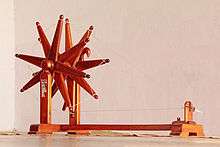
- Microfilming, lamination and preservation of negatives
- Arranging exhibitions on different aspects of Gandhi’s life, literature and activities
- Publication of the "Mahadevbhani Diary," which chronicles the entire history of the Indian freedom struggle
- The Ashram Trust funds activities that include education for the visitor and the community and routine maintenance of the museum and its surrounding grounds and buildings
- Helping and undertaking study and research in Gandhian thought and activities. Keeping in contact with those being helped. Publishing those results of study and research together with allied literature, for the benefit of all
- Observance in a suitable manner of occasions connected with Gandhi’s life
- Maintaining contact with the youth and student community and providing facilities for them to study Gandhian thought
Walking tours in Gandhi Ashram
With prior appointment from The Secretary, Gandhi Ashram Preservation and Memorial Trust, the Gandhi Smarak Sangralaya, Gandhi Ashram Ahmedabad 380 027 a walking tour can be organised. This 90-minute guided tour starts with a slide show and ends at the Library. The tour visits the following places, in order:
- Magan Niwas - Magan Gandhi - The soul of the ashram which exhibits different designs of charkhas.[3]
- Upasana Mandir - Prayer Ground where the ashramite listened to bhajans (devotional songs) and readings from the Holy Gita, Quran and Bible.[4]
- Hriday Kunj - Like the heart in the body this centrally located dwelling supplied energy to the entire place.[5]
- Vinoba-Mira Kutir - The hut where Vinoba Bhave and Madeleine (renamed Miraben by Gandhi) the daughter of the British Rear-Admiral Sir Edmond Slade stayed at different times.
- Nandini - This was the guest house of the ashram.
- Udyog Mandir - A temple of industry symbolizing self-reliance and dignity of labour.
- Somnath Chattralaya - A cluster of rooms occupied by ashramities who forsook family affairs and shared ashram life.
- Teacher's Niwas - Bapu's associates stayed at teacher's chalet
- Gandhi in Ahmedabad - This gallery exhibits major events of Gandhiji's life from 1915 to 1930 in Ahmedabad.
- Painting Gallery - Eight life size paintings have been displayed.
- My life is my message - Events which were turning points in Gandhiji's life and which ultimately changed the history of India are depicted through oil paintings and photographs.
- Library & Archives - Archives preserve the legacy of eternal Gandhi in 34,000 manuscripts, 150 felicitations, 6,000 photo negatives, and 200 files of photostats. The Library has 35,000 books including 4,500 books from Mahadevbhai Desai's personal collection and books on Gandhian thought. It is an invaluable resource for researchers. There are also many other rare books of all religions. The library's opening hours are from 11am to 6pm. Books cannot be borrowed but can be read in the library.
Gallery
 Sabarmati Ashram in 1948
Sabarmati Ashram in 1948 Statue of Mahatma Gandhi at the ashram
Statue of Mahatma Gandhi at the ashram Back view of Mahatma Gandhi's house
Back view of Mahatma Gandhi's house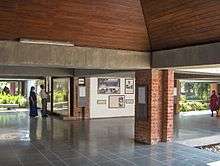 Gandhi Sangrahlay - Inside Corridors
Gandhi Sangrahlay - Inside Corridors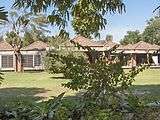 Gandhi Sangrahlay - Outside
Gandhi Sangrahlay - Outside Front view of Mahatma Gandhi's House
Front view of Mahatma Gandhi's House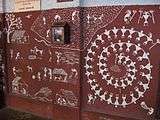 Warli Art at Sabarmati Ashram
Warli Art at Sabarmati Ashram Warli Art at Sabarmati Ashram
Warli Art at Sabarmati Ashram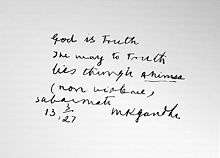 God is Truth, Circa 1927
God is Truth, Circa 1927 Beautiful view from the door of Gandhi's house
Beautiful view from the door of Gandhi's house Vinobha Kutir on the shore of Sabamati river
Vinobha Kutir on the shore of Sabamati river Gandhiji's Charkha and table
Gandhiji's Charkha and table Gandhiji's Chappal and Spectacles
Gandhiji's Chappal and Spectacles Enlarged replika of Mahatma Gandhi's signature in different languages
Enlarged replika of Mahatma Gandhi's signature in different languages The stone writings in front of Maganlaal Gandhi's kutira Hrudaya Kunja at sabaramati ashram , Ahamadaabad
The stone writings in front of Maganlaal Gandhi's kutira Hrudaya Kunja at sabaramati ashram , Ahamadaabad Artifacts used by Mahatma Gandhi and Kasturabaa Gandhi at Sabarmati Ashram , Ahamadaabad
Artifacts used by Mahatma Gandhi and Kasturabaa Gandhi at Sabarmati Ashram , Ahamadaabad
See also
- Sadaqat Ashram
- National Gandhi Museum
- Gandhi Memorial Museum, Madurai
- Eternal Gandhi Multimedia Museum
- Gandhi Heritage Portal
References
- ↑ Gandhi, Mohandas. "Gandhi Ashram Official Website".
- ↑ "My Life is My Message Gallery".
- ↑ Mandir, Magan. "Magan Niwas".
- ↑ Niwas, Upasana. "Upasana Mandir".
- ↑ Kunj, Hriday. "Hriday Kunj".
External links
- History of Satyagraha Ashram in Gujarati language - સત્યાગ્રહાશ્રમનો ઈતિહાસ By Mahatma Gandhi
- Gandhi Heritage Portal
- Sabarmati Ashram
- Sabarmati Ashram Virtal Tour
- Activities at Ashram
- Painting Gallery
- Sabarmati Ashram Museum
- Sabarmati Ashram History
- Sabarmati Ashram Trustees
- Sabarmati Ashram Institutions
- Sabarmati Ashram Observances
![]() Media related to Sabarmati Ashram at Wikimedia Commons
Media related to Sabarmati Ashram at Wikimedia Commons
